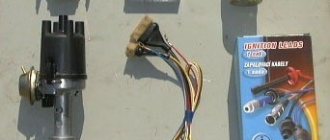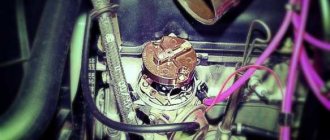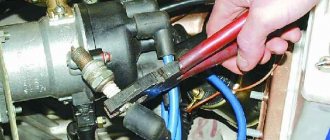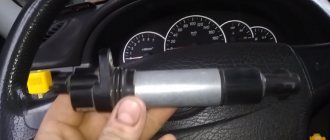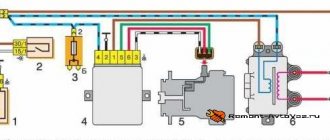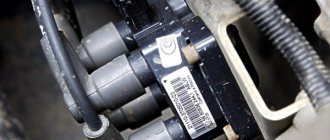04/06/2021 7,544 VAZ 2106
Author: Ivan Baranov
Often the reason for the disappearance of the spark on the spark plugs is a malfunction of the ignition coil (IC). The article describes the device, how to check the ignition coil of a VAZ 2106, its malfunctions and how to eliminate them.
[Hide]
How to check the ignition coil of a VAZ
Ignition coil VAZ 2106
The car coil is a high voltage pulse transformer. A thin wire of the secondary winding is wound around the core of the device. It contains 30 thousand turns. In accordance with the device diagram, a primary winding consisting of thick wire is located on top of the secondary winding. Both windings are connected to the car battery at one of their ends.
The second end of the primary winding is connected to the distributor. The common connection point of the coil windings is connected to the voltage switch. The core plays the role of a magnetic field amplifier. At the moment the circuit breaks, a high voltage is generated in the secondary winding, which is supplied through a wire to the spark plug for breakdown and formation of a spark.
How to check
Checking the resistance of the primary winding
When performing this work, like any other related to electrical equipment, it is necessary to disconnect the minus terminal from the battery.
So, in order to check the primary winding of the VAZ 2106 ignition coil for serviceability, you need to connect both ohmmeter wires to two side terminals, as is clearly shown in the photo below:
According to data from numerous technical repair manuals for the VAZ 2106, the resistance in this case should be within 3-4 ohms. This will indicate that the ignition coil is fully operational. As you can see, in my case, the resistance is slightly higher (but not significant), and there were no problems with the operation of the ignition system.
If the measurement value deviates greatly from the norm, this indicates a malfunction and the need to replace the part.
Checking the secondary winding
The secondary winding of the coil is checked in almost the same way, only one of the ohmmeter wires needs to be connected to the side terminal, and the second to the central one on the coil. Everything is demonstrated below:
Here the resistance data is completely different and during normal operation it should be in the region of 7.4-9.2 kOhm. Judging by the readings of the device, my case shows and confirms again that everything is fine with the coil.
To avoid any misunderstandings, I want to warn you that the figures given in this article apply to a greater extent to VAZ 2106 type B117-A ignition coils, although on many models the parameters are identical. But still, for your modification, it is better to look at the data in specialized sources.
No spark
If there is no spark even at the contacts, then there is a high probability that it is the ignition coil that has burned out. You can check it either with an ohmmeter, measuring the resistance, or by installing a new one and see if that fixes the problem!
How to connect
The procedure for removing and installing the ignition coil on a VAZ 2106
So, first you need to disconnect the central high-voltage wire leading to the distributor (ignition distributor).
Also disconnect all power wires from the coil contacts. Since they are fastened with nuts, you will need an 8 wrench for this.
If you don’t know which wires to connect to which connector later, it’s better to immediately remember or mark them somehow, so that later during installation you can connect them correctly.
Now you need to unscrew the coil body itself. It is attached to a clamp (clamp), which is pressed to the car body with two nuts. These are the ones we need to unscrew.
After the work has been done, you can safely remove the ignition coil and replace it if necessary.
The price of a new such part is about 500 rubles, or even a little cheaper. It all depends on where you buy it.
Malfunctions
If the ignition coil is faulty, the engine will not start. A characteristic sign of a faulty coil is its increased temperature when the ignition is turned off. This is easy to determine by touch.
You can verify the serviceability of the ignition coil in the following simple way. Remove the central high voltage wire from the distributor cover clamp and set a gap of 5-7 mm. Between the tip of this wire and the vehicle ground. If the coil is working properly, then in this gap, when the engine cranks, at the moment the contacts open, a strong spark with a blue tint will appear. A weak or absent spark indicates a faulty ignition coil. It can be assumed that there is a short circuit in the ignition coil windings. The most common cause of premature ignition coil failure is the ignition being turned on for a long time while the engine is not running. Due to elevated temperatures, the insulation of the ignition coil windings dries out and crumbles, which leads to a short circuit. Any detected faulty ignition coil must be replaced. To replace, you can use the ignition coil of any domestic passenger car with a 12 V electrical system voltage. Such an ignition coil usually fits at the mounting points. It must be borne in mind that the ignition coils of some domestic cars have not two, but three terminals: VK, VK-B and a third terminal without a designation. In this case, for example, to replace the coil on VAZ cars, a terminal without a designation should be connected to the distributor, the second wire should be connected to the VK-6 terminal, and the VK terminal should be left free. In addition, in this case it is also impossible to directly use the standard high voltage gap connecting the ignition coil to the distributor. It will have to be adapted or, better yet, replaced with a spare wire that does not have a ferrule at one end. When replacing a spare faulty ignition coil, all wires must be properly connected, securely fastened and insulated.
Which ignition is better: contactless or contact?
Contact ignitions are obsolete, but are still used in older cars. On rear-wheel drive VAZ models, contactless was first installed on 2107.
Let's look at the differences between contact and non-contact ignition:
Advantages of contactless ignition:
- since there is no contact group in the distributor, sparking occurs clearly;
- long coil life;
- at medium engine speeds, BSZ creates a spark 4 times more powerful than contact ignition. This is especially useful if the spark plugs are dirty, as a spark will still be produced;
- performs its functions perfectly even in cold weather;
- if the voltage in the electrical network is low, then sparking will still occur;
- thanks to the powerful, stable spark of the candles, the fuel-air mixture ignites faster;
- if BSZ is installed, then fuel consumption decreases and engine power increases;
- improved vehicle acceleration dynamics;
- BSZ is easier to maintain because the device has no moving parts.
Methods for checking the ignition coil with a multimeter for basic faults
The ignition coil is an integral part of the vehicle's starting system. Without it, it will not be possible to start the engine, whereas it is possible to start the engine without a battery, which also plays an important role in the formation of the first spark. The ignition coil is designed quite simply, but even it can become unusable due to various vehicle malfunctions or due to a factory defect. At the same time, when starting the engine, the operation of the ignition coil is not limited, and if it fails when the engine is already running, this will lead to its complete stop. Checking the ignition coil with a multimeter is a sure and easy way to determine the health of the unit and the need to replace it.
How to check the ignition coil
Checking the ignition coil is a three-step process that begins with preparation, then undergoes a visual inspection and ends with instrument testing. The unit can be checked on specialized diagnostic stands in dealer workshops or professional services. An independent check of the ignition coil is carried out using a multimeter - a universal diagnostic device with a wide range of applications.
Preparatory stage
Before proceeding directly to diagnosing the ignition coil, you need to acquire a multimeter (capable of determining voltage and electrical resistance, Ohms) and find technical documentation for the car. Various ignition coils are installed in cars, and the parameters of a specific model are written down in the car’s “passport”. If the car was bought second-hand, technical information about its units can be easily found on the Internet.
VAZ models 8 and 16 valves
Despite the similarity in engine design, the ignition system of the 1.5-liter injection 16-valve engine differs from the 1.6 16-valve engine. The 1.6 liter engine uses an electronic contactless ignition system with individual coils on each spark plug. Therefore, there was no need for an ignition module. Such a system is more reliable and cheaper to operate, since if one coil fails, there is no need to replace the entire module.
The 16-valve 1.5-liter VAZ 2112 injection engine used the same non-contact ignition system as the 8-valve engine, but a different ignition module was installed. Its catalog number is 2112-3705010. The design of the module remains the same - two ignition coils (for cylinders 1-4 and 2-3) plus switch keys in a single block. The spark is supplied to the cylinders in pairs using the idle spark method. This means that sparking occurs in two cylinders simultaneously - in one on the compression stroke (working spark), in the second on the exhaust stroke (idle spark).
Checking the ignition coil of VAZ 2104, 2105, 2107 cars
The ignition coil on VAZ 2104, 2105, 2107 can be checked without removing it from the car.
However, for a complete inspection of the coil, it is necessary to remove it from the engine compartment and clean it of dirt, rinse it with white spirit or kerosene.
We will check the appearance of the coil and the presence of a “break” and short circuit in its primary and secondary windings (a multimeter or autotester is required).
Checking the ignition coil of VAZ 2104, 2105, 2107
— Check the appearance of the ignition coil
We inspect it for mechanical deformation, cracks in the cover, and oil leaks. We replace the coil that is deformed or has oil stains; the crack in the cover can be cleaned and filled with epoxy glue.
— We check the primary winding of the ignition coil 2104, 2105, 2107 for an open circuit
We connect the probes of a multimeter or autotester in ohmmeter mode to the side terminals of the coil. See photo above.
Resistance of a serviceable primary winding at a temperature of 20 degrees. should be:
3 - 3.5 Ohm (coil B-117A)
0.45 - 0.5 Ohm (coil 27.3705)
0.57±0.05 Ohm (coil 3122.3705).
— We check the secondary winding of the ignition coil 2104, 2105, 2107 for an open circuit
We connect the probes of a multimeter or autotester in ohmmeter mode: one to the side terminal “+B” of the coil, the other to its central high-voltage terminal.
Checking the secondary winding of the ignition coil for an open circuit
Resistance of a serviceable secondary winding at a temperature of 20 degrees. should be:
7.4 - 9.2 kOhm (coil B-117A)
4.7 - 5.5 kOhm (coil 27.3705)
6.5±0.65 kOhm (coil 3122.3705).
— Check the windings of coils 2104, 2105, 2107 for a short circuit
We connect the probes of a multimeter or autotester in ohmmeter mode: one multimeter probe to the “+B” terminal of the coil, the other to its body. Resistance should tend to infinity.
Checking the ignition coil for a short circuit
If deviations in the multimeter readings from the norm are detected, replace the ignition coil with a new one.
Notes and additions
— A malfunction of the ignition coil leads to the following problems in the operation of the car engine and its systems: the engine does not start, the engine starts and stalls, the engine “troubles.” Their reasons are either a decrease in the energy of the high-voltage current generated by a faulty coil (the spark on the candles is weak), or a complete cessation of its production of this very current.
TWOKARBURATORS VK -More information on the topic in our VKontakte group
Signs of trouble
There are several characteristic signs of a faulty ignition coil. Among them:
- the motor begins to “trouble”, and this problem gets worse over time;
- in the cold the engine “troubles” until it warms up;
- interruptions in engine operation in wet weather;
- When you sharply press the accelerator pedal, there is a failure in the engine.
If the coil is faulty, on cars with an ECU, the Check Engine icon on the dashboard is activated. However, the listed signs may also indicate other malfunctions, in particular with the spark plugs. But if at least one of them appears, you need to diagnose the ignition coil(s).
How to check the ignition coil
There is probably no car enthusiast who has not had to deal with a situation in which a car engine, which was working properly before, does not start. There are a great many reasons for this problem, and one of them is a malfunction of the ignition coil, which we will consider in this article.
The primary diagnosis of this “disease” of the ignition system is not very complicated and consists of several measures:
Checking the performance of the battery.
Monitoring the functioning of the starter (determined by ear).
Checking the serviceability of the spark plugs and the presence of a spark discharge on the electrodes.
If all of the above units are in working order, and there is no spark at the spark plug electrodes, we recommend checking the ignition coil.
Ignition coil device
Before giving an answer to a very common question among novice (and not only) car enthusiasts: “How to check an ignition coil with a multimeter?”, We suggest considering its design features, which will form a basic idea of its operational functionality.
An ignition coil is a simplified analogue of an electrical transformer, the functional purpose of which is to convert low-voltage voltage coming from a source (battery or generator) into a high-voltage pulse that produces an igniting spark at the electrodes of the spark plug.
The design of the classic version of the ignition coil includes:
The primary winding is made of a small number of turns (no more than 150) of fairly thick copper wire with insulation. The function of the primary winding is to receive low-voltage pulses. Connected to terminals “K” and “B” located on the cover. Has a resistance of 3-4 ohms.
Checking for a spark
If problems with the ignition system overtake you on the road, you can check the presence of a spark (and, consequently, the performance of the coil) without a tester.
This method is addressed only to owners of cars that are not equipped with a catalyst, since this part can be seriously damaged during testing. The check is carried out in several stages:
- We fix the ignition cable on the cylinder head with tape or hold it in pliers that have good insulation. It should be located at a distance of no more than 10 millimeters from the mass;
- we start the engine (for this purpose it is better to invite an assistant, since otherwise you simply will not be able to see the spark);
- We are watching the cable. When the power unit is running, large sparks should appear between it and the ground;
- If this does not happen, you will need to disconnect the plug, turn on the ignition and make sure that sufficient voltage is supplied to the coil.
No spark on VAZ 2109 (carburetor): main reasons
Regardless of the type of engine installed (carburetor or injector), on the VAZ 2109 we are dealing with a distributor-type ignition system. On the one hand, this is good, since replacement and repair of the unit is cheap. But the resource of parts leaves much to be desired.
Appearance of the device
Device Features
The ignition coil serves to produce a spark coming from the spark plug electrodes. To put it briefly and simply, this is a small transformer that operates in pulse mode and converts 12 volts from the car into 20-30 thousand volts at the output. High-voltage wires are used to transmit the impulse, which also sometimes cause coil malfunctions.
Structurally, the VAZ 2109 coil consists of a pair of windings - secondary and primary.
- The primary winding has fewer turns, but wires with a larger cross-section;
- The secondary winding of a coil with a large number of turns, but a smaller wire cross-section.
Windings
Signs of breakdown
Often the spark at the carburetor disappears unexpectedly when the driver is not prepared for such a turn of events. But if you have enough experience and pay close attention to the behavior of your car, you can detect signs of a malfunction before the spark disappears and the engine does not start.
So, why does the spark disappear, what are the reasons and what signs may indicate a failure of the ignition coil?
- Approximately 500 kilometers before the coil’s life is over, on a cold engine the device normally starts working only after a couple of minutes of warming up. The engine starts with difficulty, but some people think that the problem is in the idle system. At the same time, the engine begins to behave unstably at low speeds. This phenomenon occurs within 10-30 seconds, so you don’t always have time to pay attention to it.
- Another short-term symptom is the engine actively shaking when starting a cold engine and holding down the gas pedal. This will happen literally for 3-5 seconds, and after pressing the pedal again, everything will return to normal.
- When accelerating or changing gears at the gearbox, the engine may produce jerks, vibrations, and the dynamics deteriorate for a short time. The downside is that such a symptom may appear for a few moments, but disappears just as quickly.
- The most obvious sign is the complete failure of the engine to try to start. The spark disappears, and therefore the chances of starting are zero.
Examination
If you notice signs of a problem with the ignition coil, or have to deal with a situation where the engine “died,” be sure to check the condition of this element.
As you test, you will be able to determine what caused the coil to fail and how the problems can be corrected.
How to check the device? The instructions are not complicated, even a beginner can handle it.
First, let's check the condition of the unit, and then check for correctness of the resistance of the coil itself.
- If the engine cannot be started, make sure that the coil itself is producing a spark at all. To do this, the central wire is removed from the distributor and a spare spark plug is connected to it.
- Now take the spark plug with pliers and place the metal casing on the breaker or motor.
- If a spark does not appear when the engine starter is turned, there is a malfunction in the ignition system.
- So check the power to the coil, or rather its presence. For this you will need a multimeter. One terminal is connected to contact B on the coil, and the second goes to ground. Turn on the ignition. If there is no voltage, the culprit is the ignition switch.
- You can start the engine in emergency mode. To do this, the plus from the battery is thrown onto contact B of the coil.
If there is voltage but there is no spark, check whether the primary winding is intact. To do this, the side low-voltage wires are disconnected from the coil and resistance measurements are taken with a multimeter. Then the secondary winding is checked.
Causes of malfunctions
There are several reasons why the ignition coil completely or partially fails. Among them:
- Mechanical damage . This may be simple aging, due to which the insulation is destroyed. There is also the possibility of oil leaking through the seals, which gets onto the insulation or coil body and destroys them. Repair in this case is hardly possible, so the best option would be to completely replace the unit.
- Damage to the contact connection . In warm weather, this may be caused by moisture getting into the engine compartment. For example, during heavy rain, driving through deep puddles, washing a car. In winter, it is likely that the reel will get hit with the composition that is sprinkled on the road surface to combat ice.
- Overheating . Individual coils are often susceptible to it. Overheating can significantly reduce the life of the ignition coils. The overheating process is difficult to control, but try to use high-quality coolant and ensure that the engine cooling system is working properly.
- Vibrations . They are especially harmful to individual ignition coils. Vibrations usually come from the cylinder head (cylinder head). To reduce the number and amplitude of vibrations, make sure that the engine is operating in normal mode (without detonation and with working mounts).
Ignition coils are quite reliable and durable components, and their failure is most often associated with aging and/or insulation breakdown. Next, we will consider methods for diagnosing coils.
How to check the ignition coil? Replacing the ignition coil of a VAZ 2107
A little theory.
The ignition coil on cars is necessary to convert a low voltage current of 12 V into a high current - 11-20 kV, which is necessary to create a spark at the spark plugs. What happens next is probably known to everyone!? The spark ignites the working mixture and a release of energy occurs, which sets the pistons in motion. As I said in my previous articles, the ignition coil is a kind of transformer, which can also be called a miniature automotive “substation”.
On the “seven”, as a rule, contact ignition systems of the B-117 A type are used. The coil itself is located in the engine compartment and is attached to the left mudguard with two studs. Also found on the VAZ 2107 are non-contact ignition systems (BSZ), in this case, coils of type 27.3705 are used, oil-filled with an open magnetic circuit, as well as type 3122.3705 dry coils with a closed magnetic circuit.
Signs of a faulty ignition coil
If, after turning the key in the ignition switch, you hear that the starter is turning, but the engine does not start, then, as a rule, this may mean that the ignition coil is not working correctly or has failed. Although there are many reasons why the engine does not start when you try to start it: spark plugs, explosive wires, problems in the fuel system (pump, fuel filter, clogged line), and so on.
But if, after all, the reason is in the ignition coil, then this can be understood by the following symptoms:
- There is no spark at the spark plugs;
- There is no current on the BB wires;
- Visual defects (cracks and chips on the reel body);
- A burning smell under the hood, which leaves traces of melting of the ignition coil (the primary or secondary winding has burned out).
How to check the ignition coil of a VAZ 2107?
Checking the ignition on a VAZ 2107 is performed using a multimeter or ohmmeter.
- It is necessary to disconnect the wires from the ignition coil terminals.
- And connect the multimeter electrodes to the terminals of the primary winding of the ignition coil.
- Check resistance. The resistance of the primary winding on a coil of type B-117 A, at a temperature of 20°C should be approximately 3-3.5 Ohms, for a coil of type 27.3705 - 0.45-0.5 Ohms.
- Connect a multimeter to the high-voltage terminal “+B” to measure the resistance on the secondary winding. The resistance of the secondary winding on a coil of type B-117 A at a temperature of 20°C should be 7.4-9.2 kOhm, for another type of coil - 27.3705 (normal resistance is considered to be 5-0.5 kOhm).
In this video you will learn in more detail how to check the ignition coil
How to replace the ignition coil on a VAZ 2107
In most cases, the coil is irreparable, that is, it is almost impossible to repair it, so if the ignition coil malfunctions, it will have to be replaced. Replacing the coil on a VAZ 2107 is quite simple; any novice car owner can handle this task.
To work you will need:
- Socket heads for “8” and “10”;
- New ignition coil.
The actual replacement process itself:
1. First of all, remove the “-” terminal from the battery.
2. Next, we remove the central explosive wire of the coil output; to do this, simply pull it up with a minimum of effort.
3. Using the “8” socket, unscrew the nuts securing the terminals of the wires connected to the coil contacts.
4. Next, remove the coil itself; to do this, unscrew the two nuts securing the coil.
5. Remove the ignition coil and put a new one in its place.
Further assembly is carried out in reverse order.
Thank you for your attention, see you again at VAZ Do-It-Yourself Repair.
Why might there be no spark?
The list of situations in which there may be no spark in car spark plugs is very long; anything can affect this. Let's try to identify the most frequently occurring causes on the VAZ models 2109, 2114, 2110, 2106:
- weak battery charge;
- the problem is in the high-voltage wires;
- there are problems with the ignition coil;
- problems with the low voltage circuit;
- problems with the ignition distributor.
You should also pay attention to the quality of contacts and electrical components. The contacts, of course, can be checked quite easily by tugging them a little with your fingers
In addition, it is advisable to inspect all elements of the ignition system. If there is dirt, oil, or water on them, they must be wiped off immediately with a dry cloth. After this, you can try to start the car.
Checking the ignition coil
To diagnose the coil, you need to remove the main wire from the distributor cap. Next, we try to crank the starter to see a spark from the wire.
- A spark has formed - this indicates that the coil is working properly. So the problem is with the breaker.
- If there is no spark, the fault must be looked for in the ignition coil.
If it has been determined that the problem lies specifically in the ignition coil, then it will have to be replaced. In “middle-aged” VAZ cars, especially 2109, 2106, 2114, 2110, this phenomenon is by no means rare.
Checking the ignition distributor
If there is a possibility that the problem lies specifically in the breaker, then in order to make a diagnosis, you need to inspect its cover from the inside:
- Visually, the cover is intact and has no signs of damage - wash it, preferably with gasoline, and put it back in place.
- If there are any visible signs of breakage or if there are any cracks, the cover will need to be replaced.
You also need to check the central contact of the breaker for any “freezes”. This is easy to do: just move its carbon tip.
Another check that can and even needs to be done is checking the insulation of the breaker rotor. This is done like this:
- First, the central explosive cable is located at a distance of five to eight millimeters from the electrode.
- Next, you need to close and open the contacts several times. All this must be done with the ignition on.
If even the slightest spark jumps in this small gap, this indicates a rotor malfunction. In such situations, he is replaced.
Checking the low voltage circuit
To diagnose such a circuit, you can use a 12-volt test lamp with a power of up to three watts. This light bulb must be connected with one contact to the ground of the car, and the other to the low voltage terminal. After manipulating the connection manually, the contacts of the breaker are closed and the ignition is turned on. If the circuit is working properly, then when the contacts are closed, the light goes out, and when the contacts are open, it lights up. When this does not happen, you need to start looking for a problem in the coil winding or in the cables.
If the lamp is constantly on, this indicates one of the following types of malfunctions:
- The breaker contacts are heavily oxidized.
- The wire leading from the lever to the breaker terminal is broken.
- The wire that connects the housing to the movable disk is broken.
The oxidized wires need to be cleaned, after which the system will work. In any other case, more in-depth intervention is necessary.
Checking and replacing the ignition coil
On rear-wheel drive cars of the classic family with a carburetor engine, the ignition coil (in automotive circles it is often called a “bobbin”) is installed in the engine compartment on the left mudguard and secured with two nuts.
On later injection versions (VAZ 2107 injector), an ignition module is installed, mounted on the cylinder block.
Before deciding to replace the coil, you should make sure that it is not working, otherwise the repair may be useless and money will be wasted.
Methods for checking the ignition coil
The simplest method, which does not require special equipment, but is unsafe. Remove the central high-voltage wire and crank the engine by turning the ignition key. At the same time, we lean the removed wire against ground or the car body. If there is a spark, then the coil is ok. An assistant may be needed for this operation.
The second method, which is also more accurate, is to measure the resistance of the coil windings using a multimeter measuring device or “popularly” using a tester.
Measuring ignition coil resistance
We clean the coil contacts (studs on the body). The first check is the resistance of the primary winding. To do this, connect an ohmmeter to two studs and take measurements. Depending on the type of coil being tested, the resistance should be within the following limits: coil 2101-2107 B-117A = 3-3.5 Ohm; coil 2108-099 027.3705 = 0.45-0.5 Ohm.
Then we check the resistance in the secondary winding circuit. We connect one terminal of the tester to the central terminal of the high-voltage wire, and leave the second terminal of the probe at the terminal of the primary winding. In this case, the resistance of the working coil should be as follows: B-117A = 7.4-9.2 kOhm; 027.3705 = about 5 kOhm.
How to replace the ignition coil with a new one?
Replacing the ignition coil (bobbin) VAZ 2101-2107
1) Remove the high-voltage wire from the coil cover.
2) Using a size 8 wrench, unscrew the nut from the terminal marked “B” on the coil cover and remove the ends of the green and brown wires. To avoid losing small nuts, we recommend putting them in place.
3) Similarly, disconnect the blue wire with a black stripe from the terminal marked with the letter “K”.
If the colors of the wires turn out to be different, and this is possible, mark their position before disconnecting. From terminal “B” the wire is laid in the wiring harness, from terminal “K” - one is connected to the terminal of the ignition distributor, the second goes into the harness.
4) Using a 10mm wrench, unscrew the coil mounting nuts three to four turns.
5) Remove it from the car.
We install the new coil in the reverse order, observing the written order of connecting the wires.
Instructions for connecting short circuit
To carry out the operation of removing and replacing the short circuit, you need to prepare:
- heads or keys for “8” and “10”;
- extension;
- small wrench or ratchet.
The short circuit is located in the left corner of the engine compartment.
The replacement procedure consists of the following steps:
- First, remove the central high-voltage wire from the ignition distributor (distributor).
- Next, you need to use the key set to “8” to disconnect the supply wires from the short-circuit contacts. To correctly connect the wires after installing a new unit, it is better to remember how they are connected or mark them.
- At the next stage, you need to unscrew the two nuts securing the clamp that holds the short circuit housing.
- After unscrewing the clamp nuts, you can remove the coil.
- Next, a new product is installed, all wires are connected according to the marks.
Assembly is carried out in reverse order.
Photo gallery “Replacing a short circuit on a VAZ 2106”
1. Unscrew the clamp nuts.
2. Disconnect the high-voltage wires.
3. Install a new product
After installing a new short circuit, you need to check the operation of the internal combustion engine.
Have you changed the ignition coil on a VAZ 2106 yourself?
Survey
- Yes
- No
Loading …
How the connection is made
So, the order of connecting the armored wires must be consistent. This is extremely important, because each cylinder of the internal combustion engine must have its own wire. The ignition coil distributor has corresponding sockets that are numbered. Everything is clearly provided for: it will be very difficult to confuse one or another wire connecting the spark plugs to the distributor-coil.
As mentioned above, the connection diagram for the armored wiring depends on the specific car model. For example, the car of the fourteenth VAZ model was equipped with two types of armored wiring: the version before 2004 and after. The difference is due to the fact that before this year 4-pin distributor coils were installed, after which 3-pin distributors were installed.
The photo below shows the layout of armored wiring on a VAZ before 2004 and after
In order not to confuse anything during the process of connecting armored wires, it is recommended to adhere to the following:
- Disconnect the battery terminals;
- Remove the old armored wires from the ignition module;
- Connect new ones according to the connection diagrams;
- Insert the battery terminals into place;
- Start the engine.
If the engine starts easily, then everything was done correctly. When installing the wiring, it is recommended not to connect them together with plastic clamps, but to use the comb holder included in the kit for this purpose.
And finally, let’s say that armored wires should be changed regularly, after a certain period of time. For example, on the same VAZ 2114 - every 30,000 km.
VAZ 2101 vehicles are equipped with a contact battery ignition system. The task of this system is to timely supply a spark to the engine cylinders to ignite the fuel mixture.
It includes an ignition coil in which a high-voltage pulse is formed, a distributor-breaker (also known as a distributor) that distributes the pulse among the cylinders, spark plugs that provide a spark in the cylinders, an ignition switch that turns on and off the power supply to the coil, and a battery - a source of electricity. , conventional wiring and high voltage wires.
1 - Ignition switch, 2 - Ignition coil, 3 - Ignition distributor, 4 - High voltage wires, 5 - Spark plug, 6 - Capacitor, 7 - Battery, 8 - Voltage generator, 9 - Distributor rotor, 10 - Cam mechanism, 11 -Breaker contacts
Coil device
The ignition coil, both in the case of the VAZ-2106 and in other cars, is only one of the components of the engine starting system. It also includes:
• lock; • distributor; • candles; • cables.
The coil itself is a completely ordinary pulse high-voltage transformer. Its components:
• a core with a primary winding made of thin wire; • secondary winding - it is made of thicker wire.
Both reels are connected to the machine's battery. The core provides voltage transmission. As a result, a fairly large charge is created on the secondary winding after transformation, which is directed to the spark plugs. These, in turn, spark and ignite the fuel-gas mixture.
How are ignition wires different from regular ones?
ATTENTION! A completely simple way to reduce fuel consumption has been found! Don't believe me? An auto mechanic with 15 years of experience also didn’t believe it until he tried it. And now he saves 35,000 rubles a year on gasoline!
So, the ignition system wires are otherwise called high-voltage or armored wires. This is an essential part of the system through which electrical impulses are transmitted. At the moment when voltage is applied to the spark plugs, the combustible mixture (FA) ignites. Thanks to this, a new cycle of operation of the internal combustion engine begins.
The design of armored wires, in contrast to conventional ones, differs markedly. So, in addition to the copper core, which is responsible for conducting current and protection (insulation), they also contain tips and plastic caps.
What are metal tips and protective caps for? The former successfully perform the functions of contacts, the latter protect the wires from dirt and dust. In addition, the armored wire ends are manufactured to fit precisely into the spark plug sockets and into the holes on the distributor.
Important point. The resource and service life of the armored wires as a whole depends on how well the tips are made.
When choosing between one or another armored wire model, you should keep two important points in mind. The first is resistance, and the second is their breakdown voltage. The relatively better transmission of electrical impulses is, of course, associated with a low resistance value. As for the second value, it directly affects the resistance to electrical breakdowns and short circuits.
The table below shows various resistance values of armored wiring from manufacturers Tesla, Caesar, Elephant and others. Of course, Tesla has received the most approval from car owners around the world. And along with good resistance, they are also distinguished by excellent breakdown voltage.
The price for a set of Tesla armored wiring does not, as a rule, exceed 500-600 rubles.
| Manufacturer | Resistance on cylinder No. 1 (kOhm) | Resistance on cylinder No. 2 | Resistance on cylinder No. 3 | Resistance on cylinder No. 4 | Breakdown voltage (kV) |
| Tesla | 3..27 | 4..16 | 5..02 | 6..26 | 50 |
| Cezar | 3..1 | 3..53 | 4..23 | 5..34 | 50 |
| Finwhale | 1..95 | 2..18 | 2..6 | 3..42 | 50 |
| Ween | 6..17 | 6..57 | 7..52 | 9..89 | 35 |
| Slon | 4..24 | 4..74 | 5..19 | 7..6 | 50 |
Distributor
On VAZ 2101 models until 1980, a distributor (distributor) of the R-125B model was used. Its peculiarity was the absence of a vacuum regulator; there was only a mechanical type octane corrector, which made it possible to slightly change the ignition timing (IZ).
Beginning in 1986, together with the installation of the Ozone carburetor, a distributor equipped with an OZ vacuum regulator (model 30.3706), the design of which is described below, began to be installed on VAZ engines.
Model 30.3706 consists of a distributor, a breaker and two regulators - centrifugal and vacuum.
The distributor ensures the distribution of coil pulses among the spark plugs in accordance with the operating order of the power plant.
It consists of a rotating rotor and fixed segments located in a plastic cover. There are two contacts on the rotor - central and side, with an interference suppression resistor attached between them. A graphite electrode is pressed from above to the central contact; for better contact, pressing is carried out by a spring.
The distributor works like this:
the voltage from the secondary winding is supplied to the rotor, then through a spark gap of approximately 0.5 mm it enters one of the segments of the distributor cover, then through high-voltage wires to the spark plug, which ensures the appearance of a spark.
The breaker ensures that the electrical circuit opens at the right time. Its design includes a cam washer with edges and a contact post. The edges of the cam washer are specially shaped to ensure quick opening of the contacts, smooth closing of the contacts and absence of rattling.
The rotating cam alternately closes and opens the contacts, thereby interrupting the voltage supply to the primary circuit of the coil.
The breaker and distributor must work synchronously with the crank mechanism. To ensure synchronization, the cam washer and rotor are located on the same shaft, and are driven by the camshaft.
Centrifugal regulator – provides a change in the angle of rotation in accordance with the rotation of the knees. shaft
A plate with movable weights is welded to the top of the cam bushing. With increasing knee speed. shaft, the weights move apart due to centrifugal force, turning the plate together with the cam in the direction of shaft rotation. This ensures earlier opening of the contacts (increasing the angle of contact).
Vacuum regulator – adjusts the OP angle depending on the load of the power unit and the position of the throttle valve.
It is attached to the distributor and includes a housing and a cover. The body is divided by a plastic membrane into two cavities, one of the cavities is connected to the throttle space in the carburetor, and the second to the atmosphere. The membrane can act on the breaker through traction.
As the load decreases, the filling of the cylinders with the combustible mixture and the pressure during ignition decreases, and this requires an increase in the angle of ignition. To do this, the membrane bends (under the influence of a pressure difference) and rotates the breaker to the desired angle.

